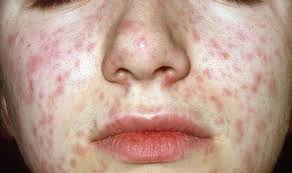Measles is a highly contagious, serious disease caused by a
virus. In 1980, before widespread vaccination, measles caused an
estimated 2.6 million deaths each year.

The disease remains one of the leading causes of death among young children globally, despite the availability of a safe and effective vaccine. Approximately 114 900 people died from measles in 2014 – mostly children under the age of 5.
Most measles-related deaths are caused by complications associated with the disease. Complications are more common in children under the age of 5, or adults over the age of 20. The most serious complications include blindness, encephalitis (an infection that causes brain swelling), severe diarrhoea and related dehydration, ear infections, or severe respiratory infections such as pneumonia. Severe measles is more likely among poorly nourished young children, especially those with insufficient vitamin A, or whose immune systems have been weakened by HIV/AIDS or other diseases.
In populations with high levels of malnutrition and a lack of adequate health care, up to 10% of measles cases result in death. Women infected while pregnant are also at risk of severe complications and the pregnancy may end in miscarriage or preterm delivery. People who recover from measles are immune for the rest of their lives.
The virus remains active and contagious in the air or on infected surfaces for up to 2 hours. It can be transmitted by an infected person from 4 days prior to the onset of the rash to 4 days after the rash erupts.
Measles outbreaks can result in epidemics that cause many deaths, especially among young, malnourished children. In countries where measles has been largely eliminated, cases imported from other countries remain an important source of infection.
The disease remains one of the leading causes of death among young children globally, despite the availability of a safe and effective vaccine. Approximately 114 900 people died from measles in 2014 – mostly children under the age of 5.
Signs and symptoms
The first sign of measles is usually a high fever, which begins about 10 to 12 days after exposure to the virus, and lasts 4 to 7 days. A runny nose, a cough, red and watery eyes, and small white spots inside the cheeks can develop in the initial stage. After several days, a rash erupts, usually on the face and upper neck. Over about 3 days, the rash spreads, eventually reaching the hands and feet. The rash lasts for 5 to 6 days, and then fades. On average, the rash occurs 14 days after exposure to the virus (within a range of 7 to 18 days).Most measles-related deaths are caused by complications associated with the disease. Complications are more common in children under the age of 5, or adults over the age of 20. The most serious complications include blindness, encephalitis (an infection that causes brain swelling), severe diarrhoea and related dehydration, ear infections, or severe respiratory infections such as pneumonia. Severe measles is more likely among poorly nourished young children, especially those with insufficient vitamin A, or whose immune systems have been weakened by HIV/AIDS or other diseases.
In populations with high levels of malnutrition and a lack of adequate health care, up to 10% of measles cases result in death. Women infected while pregnant are also at risk of severe complications and the pregnancy may end in miscarriage or preterm delivery. People who recover from measles are immune for the rest of their lives.
Transmission
The highly contagious virus is spread by coughing and sneezing, close personal contact or direct contact with infected nasal or throat secretions.The virus remains active and contagious in the air or on infected surfaces for up to 2 hours. It can be transmitted by an infected person from 4 days prior to the onset of the rash to 4 days after the rash erupts.
Measles outbreaks can result in epidemics that cause many deaths, especially among young, malnourished children. In countries where measles has been largely eliminated, cases imported from other countries remain an important source of infection.



No comments:
Post a Comment